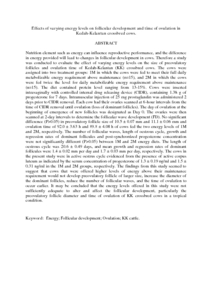Citation
Amri, Azizah and Yaakub, Halimatun and Johari, Ahmad
(2013)
Effects of varying energy levels on follicular development and time of ovulation in Kedah-Kelantan crossbred cows.
Malaysian Journal of Animal Science, 16 (2).
pp. 21-28.
ISSN 1394-3227
Abstract
Nutrition element such as energy can influence reproductive performance, and the difference in energy provided will lead to changes in follicular development in cows. Therefore a study was conducted to evaluate the effect of varying energy levels on the size of preovulatory follicles and ovulation time of Kedah-Kelantan (KK) crossbred cows. The cows were assigned into two treatment groups: 1M in which the cows were fed to meet their full daily metabolizable energy requirement above maintenance (n=15), and 2M in which the cows were fed twice the level for daily metabolizable energy requirement above maintenance (n=15). The diet contained protein level ranging from 13-15%. Cows were inserted intravaginally with controlled internal drug releasing device (CIDR), containing 1.38 g of progesterone for 7 days. Intramuscular injection of 25 mg prostaglandin was administered 2 days prior to CIDR removal. Each cow had their ovaries scanned at 6-hour intervals from the time of CIDR removal until ovulation (loss of dominant follicles). The day of ovulation at the beginning of emergence of new follicles was designated as Day 0. The ovaries were then scanned at 2-day intervals to determine the follicular wave
development (FD). No significant difference (P>0.05) in preovulatory follicle size of 10.5 ± 0.07 mm and 11.1 ± 0.06 mm and ovulation time of 92.0 ± 3.63 h and 89.8 ± 4.08 h of cows fed the two energy levels of 1M and 2M, respectively. The number of follicular waves, length of oestrous cycle, growth and regression rates of dominant follicules and post-synchronized progesterone concentration were not significantly different (P>0.05) between 1M and 2M energy diets. The length of oestrous cycle was 20.6 ± 0.49 days, and mean growth and regression rates of dominant follicules were 1.4 ± 0.02 mm per day and 1.7 ± 0.03 mm per day, respectively. The cows in the present study were in active oestrus cycle evidenced from the presence of active corpus luteum as indicated by the serum concentration of progesterone of 1.3 ± 0.19 ng/ml and 1.5 ± 0.31 ng/ml in the 1M and 2M groups, respectively. The findings from this study seemed to suggest that cows that were offered higher levels of energy above their maintenance requirement would not develop preovulatory follicle of larger size, increase the diameter of the dominant follicles, reduce the number of follicular waves, and the time of ovulation to occur earlier. It may be concluded that the energy levels offered in this study were not sufficiently adequate to alter and affect the follicular development, particularly the preovulatory follicle diameter and time of ovulation of KK crossbred cows in a tropical condition.
Download File
![[img]](http://psasir.upm.edu.my/29512/1.hassmallThumbnailVersion/Effects%20of%20varying%20energy%20levels%20on%20follicular%20development%20and%20time%20of%20ovulation%20in%20Kedah.pdf)  Preview |
|
PDF (Abstract)
Effects of varying energy levels on follicular development and time of ovulation in Kedah.pdf
Download (86kB)
| Preview
|
|
Additional Metadata
Actions (login required)
 |
View Item |

